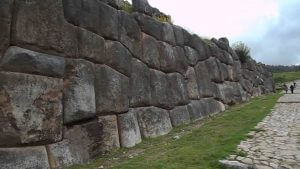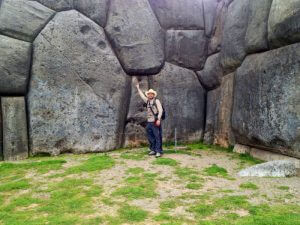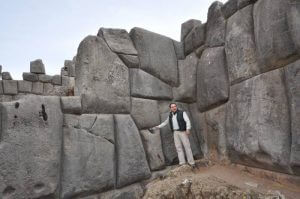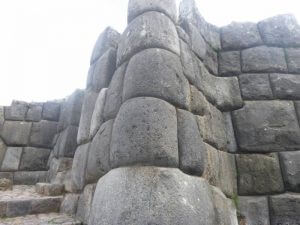
Study: Ultrasound causes damage to the brain
 30. 04. 2024
30. 04. 2024




 30. 04. 2024
30. 04. 2024


 28. 04. 2024
28. 04. 2024

 8
8
 15. 04. 2024
15. 04. 2024

In history lessons on the subject of antiquity, it leaves a strong impression on the pupils of the story of how the Egyptian pyramids were built. For the rest of his life, a picture is stored in his memory, where under the blazing African sun, in the endless desert, under the whips of the guards, the slaves drag many blocks of stone, which are intended for the construction of huge tombs. living gods, pharaohs.
Children's hearts are filled with pain and compassion for the suffering and anger towards the oppressors. But the question arises in inquisitive heads: were ancient people really able to break, work, transport and place these huge stones in the designated place? Did they have the appropriate technologies and tools to do so?
Initial doubts grow over time in the belief that pyramids and other megalithic structures were not built as described in official history. We will try to explain this with the example of the Peruvian temple complex Sacsayhuamán.
Skládání starých mistrů
The Sacsayhuamán temple and fortress complex is located in the South American Andes near the Peruvian city of Cuzco, the former Inca capital. There are several variants of the translation of this difficult-to-pronounce name from the language of Quechua: the rich falcon, the royal eagle, the contented hawk, the marble head…
Three zigzag walls, one above the other on a slope, are made up of huge blocks of stone. The largest of them weighs 350 tons and is 8,5 meters high. When you look at the wall, you remember the computer game tetris, where the individual elements are folded so that they fit together.
 The stones are machined in such a way that one block has a protrusion and an adjacent depression that corresponds to the protrusion so that they fit together. This ensured the coherence and stability of the walls in the area where earthquakes often occur. This is done so carefully that you do not insert a sheet of paper between them.
The stones are machined in such a way that one block has a protrusion and an adjacent depression that corresponds to the protrusion so that they fit together. This ensured the coherence and stability of the walls in the area where earthquakes often occur. This is done so carefully that you do not insert a sheet of paper between them.
But what giants played this "computer game"? According to the official version, Sacsayhuamán was built in the 15th - 16th century AD The construction was started either during the reign of the 10th Inca, Túpac Yupanqui (1471 - 1493), or under his father Pachacútec Yupanqui (1438 - 1471).
Building took more than 50 years and was interrupted by the death of Huayna Cappada (1493 - 1525) when the civil war broke out and then the conquest of the Inca empire by the Spanish conquistadors.
In the 16th century, the Spanish poet and historian Garcilaso de la Vega described Sacsayhuamán in his book History of the Inca Empire: “You cannot imagine its dimensions unless you saw it with your own eyes. When you examine the building up close, you are so amazed that the idea creeps in if it wasn't all built with magic and it's not the work of humans, but demons.
It is built of such huge stones and in such numbers that many questions arise: how could the Indians break these blocks off the rock, how did they transport them, how did they process and assemble them with such precision? After all, they did not know metal and did not have tools for carving stone, they did not have cars or draft animals for transport. In fact, neither wagons nor draft animals capable of carrying such cargo exist anywhere in the world. The stones are so huge and the mountain roads are uneven… “
War of the gods
Today, many scholars believe that Sacsayhuamán and other monuments of Cuzco are older and date back to before  Inky. "The civilization we are talking about," explains the paleocontact supporter, writer Andrei Sklyarov, "is at least 10 years old."
Inky. "The civilization we are talking about," explains the paleocontact supporter, writer Andrei Sklyarov, "is at least 10 years old."
Today, this version is widespread among Peruvian archaeologists and historians, the Incas came to these places, saw stone buildings and settled here.
But what was the mysterious and powerful civilization that had technologies that we have not "worked on" yet? Where did she go?
In the mythologies of almost all nations of the world there are legends about the wars of the gods. Thus, we can assume that many thousands of years ago there was indeed a highly developed civilization on Earth that was capable of processing, transporting, and planting multi-ton stone blocks.
It was wiped out in World War II, in which nuclear or even more powerful space weapons were used. The effect of high temperatures is indicated by the molten stones in the complex.
Near the Sacsayhuaman there is a lake of regular shape, which the Incas considered to be sacred. Its bottom has the form of a perfect funnel and could be formed at the site of a nuclear explosion. Some rocks are scattered around the explosion. It is possible for the fortress to be exposed to a nuclear attack.
There is one more, fairly eccentric theory that the local ancient inhabitants were able to soften the stone to the consistency of the plasticine, and then they could very easily form it. Would it be possible?
It is said that a small bird, similar to our kingfisher, lives in the Peruvian and Bolivian forests that cover the slopes of the Andes. It nests only on steep rocks near mountain streams and in small perfectly round crevices.
The colonel of the British Army, Percy Fawcett (1867 - probably 1925), who led the topographic work in the Andes, found that these cracks in the limestone were created by the birds themselves.
When it finds a suitable rock, the bird clings to it and begins to rub the surface of the rock in a circular motion with the leaf of the plant it holds in its beak until the leaf is ground. Then he flies for a new letter and continues his patient work.
After a certain period of such processing of the stone, after 4-5 changes of leaves, the bird begins to peck into the rock and under the blows of its beak, the stone is chipped. It doesn't take long, a round hole appears in the rock, in which the bird can then lay eggs and bring out the young.
In his diaries published later in England, Colonel Fawcett mentions a case told to him by an engineer who had worked for a long time in the management of mines in Cerro de Pasco, Peru. On Sunday, the engineer set out to explore several tombs with several Europeans and Americans.
They hired a guide to carry out the excavation work and took a few bottles of brandy to "lift the spirit and courage." They supported courage, but found nothing interesting in the tombs, except for one large clay and sealed  containers.
containers.
When they opened the container, they found a thick dark and very unpleasant smelling liquid. The indignant American tried to "entertain" her guide, but he very vehemently resisted.
During the skirmish, the container broke and the contents spilled onto the stones. The liquid and the stone interacted to form a kind of paste that could be formed like plasticine.
Let's assume that the ancient Peruvians were really able to soften the stone, but that does not solve the problem of how huge blocks were transported.
And can not be concrete?
And what if they weren't huge multi-ton boulders that had to be dragged by hordes of slaves? The walls are not made of granite stones, as many researchers have assumed, but of a local type of limestone. This is also confirmed by Aleksej Kruzer in his article "On the question of the origin of the material of the blocks that make up the walls of the Sacsayhuamán fortress in Cuzco".
Limestone is the basic raw material in the production of cement, by the way, the secrets of the production of this building material were known to the inhabitants of Mesopotamia around 2500 BC, as well as the ancient Egyptians and Romans. So why couldn't the ancient Peruvians make cement by burning limestone and mixing it with certain additives?
 The next stage is the production of concrete, which after its hardening acquires the strength of the stone and does not differ from it even in appearance. Then there is no need to move huge blocks of stone. All you have to do is make the necessary molds and fill them with the concrete mix. Then build a new formwork on this block and fill it. And so layer by layer and the result is a wall.
The next stage is the production of concrete, which after its hardening acquires the strength of the stone and does not differ from it even in appearance. Then there is no need to move huge blocks of stone. All you have to do is make the necessary molds and fill them with the concrete mix. Then build a new formwork on this block and fill it. And so layer by layer and the result is a wall.
Well-known creators of the eccentric "new chronology", academician Anatoly Fomenko and Gleb Nosovsky, claim that this is how the pyramids at Giza were built, made of concrete blocks. And it is possible that, unlike their other theories, this may be quite likely.
This method of construction requires neither armies of slaves nor laser cutting knives or flying equipment to transfer huge stones. Suppose this hypothesis is too common and simple to accept. We always want to believe that this is something grandiose, but in reality the solutions are ingeniously simple and straightforward.